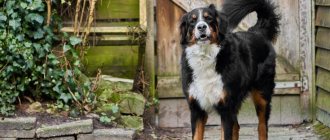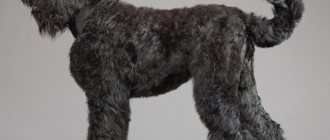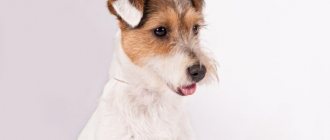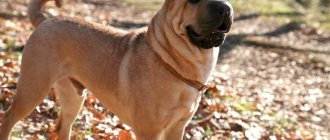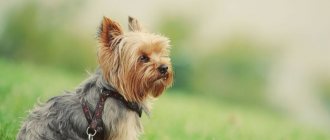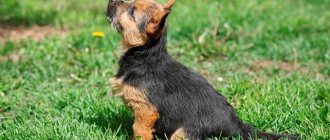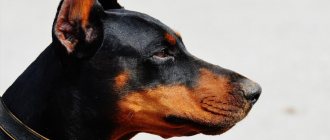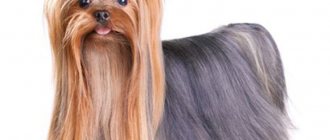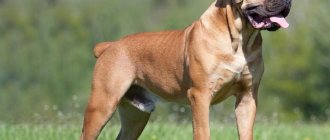The Toy Terrier is a decorative dog that has won the hearts of city residents.
Today, increasingly at social events, famous personalities appear in the company of these funny creatures.
Toy terriers are regaining the glory of salon dogs that originally belonged to them since the 18th century, when they were regulars in the living rooms of aristocrats.
The custom of keeping charming little ones in the house came to Russia along with the fashion for everything English.
The breed was bred in England for purely pragmatic purposes for hunting rats.
The attractive appearance and miniature size of terrier dogs appealed to noble people, and the dogs gradually turned into decorative ones.
Origin story
In Russia, toy terriers were very popular until the beginning of the 20th century. After the revolution, the breeding of such a “bourgeois” breed was not welcomed; there was no influx of new blood, as well as contacts with Western dog handlers.
At the end of the 50s, enthusiasts made an attempt to revive the breed, collecting its representatives bit by bit . The result of selection work was a new breed - the Russian Toy Terrier, which includes smooth-haired and long-haired varieties.
The breed standard was adopted in 1965.
The International Association of Cynologists officially registered the breed in 2006 under the name “Russian Toy”.
The Russian Toy and the English Toy Terrier have many differences; they are different breeds that have a common ancestor.
For an “Englishman”, according to the standard, only black and tan color is acceptable, while Russian Toys, in addition to the standard black, can be brown, chocolate, red, fawn and even blue and lilac.
Lilac and blue colors are obtained if the toy terrier genes contain a recessive, weakening color . This gene reduces the saturation of the shade of the coat, as if blurring it.
Black puppies with this gene are born grayish-blue, and brown puppies are born reddish-blue, called lilac.
Marriage or breed
Tribal marriage among the Toys includes:
- malocclusion (overbite or underbite);
- a significant number of white spots;
- white color;
- bald spots in smooth ones;
- lack of fringe on the ears of long-haired dogs;
- hanging ears (smooth-haired);
- short legs;
- aggressiveness;
- too tall, heavy weight.
According to the breed standard, the toy should be elegant and compact.
Main characteristics of the breed:
- squareness. The height at the withers is equal to the length of the body;
- high thin paws;
- small head. The transition from forehead to muzzle is clearly defined. The muzzle makes up one third of the skull.
- eyes are round, convex, large;
- the color of the nose, lips, eyelids depends on the color;
- ears are high-set, hanging (with fringe);
- the neck is graceful, slightly curved;
- back straight;
- chest deep;
- the tail is raised above the horizontal line (if not docked);
- The coat is short, shiny or long with feathering. The more the feathering contrasts with the length of the hair on the body and head, the better.
Expert opinion
Kozhevin Semyon Kirillovich
Expert dog handler.
For me, the Russian Toy is a small dog for big love. Ideal for home and apartment. He eats little and requires little space. She doesn't need expensive grooming. Very comfortable in everyday life. Like any terrier, it needs training. Any dog, regardless of size, must take an obedience course.
Features of care
The Russian Toy Terrier is a lap dog. Its size and habits are ideal for keeping even in a small apartment.
Walks
Walking is not as necessary for a miniature pet as for its larger counterparts. He has enough apartment space for proper growth and entertainment. However, you cannot completely give up walking.
You should teach your puppy to walk gradually, from 2-3 months. The first time, go out for a short time and hold the baby in your arms. Try to ensure that walks take place in a quiet place where the animal will not be frightened by street noise or strangers. In further exits, be guided by the pet’s reaction - if he does not show signs of panic, gradually let him off your hands.
By the way, a dog’s trembling, as a rule, does not mean fright - it is a sign of passion and interest, emotional arousal.
Be sure to use a leash to control your dog. Russian Toy Terriers are even-tempered and calm animals, but they are also brave and curious. The baby will definitely explore everything around, eager for adventure, you must be able to restrain him.
Nutrition and vitamins
The toy terrier's food should be fresh and of high quality. Dogs' intestines are shorter than humans', and in miniature breeds they are even smaller. This means that the digestion period is also short, and toxins and harmful substances do not have time to be filtered out so thoroughly, easily causing various gastrointestinal disorders.
For the first weeks, the puppy should be fed as often and with the same food that he was fed by the breeder. New types of food are introduced no more than once a week.
Fatty and rough foods are not recommended; sweets and spices are strictly prohibited.
During the growing period of the toy, from three to six months, the diet should be enriched with vitamins, proteins and calcium. For small dogs, this is the time of most active growth. The future health of your pet depends on a complete diet.
Health
Vaccination is the most important factor that will help protect the health of this generally healthy dog with a strong immune system. The first vaccinations are given at 2-3 months. This is followed by vaccination every six months, and after that - a rabies vaccination. Adult animals need vaccinations annually.
Typical diseases of the breed are:
- Eye diseases.
- Inflammation of the ears.
- Dislocations, especially of the kneecap.
The best prevention of such diseases is compliance with hygiene and rules for safe handling of the dog.
Appearance care
Caring for the toy's appearance is minimal. Bathing once a season and combing the “fringe” on the ears of long-haired dogs is quite enough to maintain the beauty of the coat. There is no undercoat, which means that the owner of the toy is spared from regular combing, trimming, and shedding.
But you should pay attention to the cleanliness of your eyes and ears every day - monitor the color and amount of discharge, and remove it with a damp cotton swab.
Photos of lilac toy terrier colors
“Pink Ice” is a poetic name for the purple color of the toy.
Lilac and tan
The color is pinkish-brown with a blue or gray tint . The wool has a bluish, silver, gray-pink tint. The nose matches the color or is gray. Maybe with a tan mark.
Lilac with red
Red color with an unusual shade. The nose is light brown, gray, the eyes are light.
Isabella
The coat color is pinkish-cream with a blue or gray tint.
Gray slate nose, gray rather than black mask on the muzzle . The tint of the coat is bluish, silver or dirty pink.
There may be grey, pinkish-gray or bluish shading on the back and ears. Isabella does not have a tan.
Description of the breed
There are certain standards for the Smooth-haired Russian Toy Terrier breed, which were adopted after many years of selection. Below you can find a general description of the parameters of an adult individual, which fully complies with accepted standards.
General appearance and proportions of the body
The Smooth-haired Russian Toy Terrier is an elegant, miniature dog. An elegant, thin build and lean muscles are important distinguishing features of the breed. The sexual type of Russian toys is weakly expressed, but noticeable in behavior. In accordance with the breed standard, the height of the dog should be 22 - 27 centimeters, the length of the withers should be equal to the length of the body, the chest should reach the level of the elbows, the skull should be longer than the muzzle, and the weight of an adult should not exceed three kilograms.
The shapes and sizes of body parts of a dog of the Smooth-haired Russian Toy Terrier breed, according to the standard, are as follows:
- high, but not too wide skull, rounded forehead;
- the nose is black, or to match the color, small, well-opened nostrils;
- muzzle moderately pointed, tapering towards the nose;
- lips are thin, black or matching color;
- straight bite, medium-sized white teeth;
- poorly defined cheekbones;
- expressive eyes, round in shape, wide-set, dark, conscious and friendly;
- high-set, large ears, shaped like an isosceles triangle;
- the neck is long and dry;
- the back is straight, the lower back is muscular, may be slightly convex, short;
- toned stomach;
- the tail has the shape of a saber or sickle, medium length;
- the coat is short, close-lying, without undercoat, there are no bald patches;
- the skin is thin and fits tightly to the body;
- toned belly.
Varieties of color
There are several color options for the Russian Smooth-haired Toy Terrier dog, namely:
- black and tan;
- brown and tan;
- red with black;
- red and blue;
- ginger;
- red with brown;
- red with lilac;
- cream;
Character
The breed's character is energetic. Although the dog is small in size, it is very active and loves to play with its owner. Smooth-haired Russian Toys are loyal to their owner and love walks, so dogs of this breed need regular walking no less than large breeds of dogs. Russian Toy Terriers are often called “bells”, because when a stranger appears in their field of vision, they bark almost continuously.
Like most dwarf breeds, the smooth-haired Russian Toy has the disadvantage of increased aggressiveness. However, with the right upbringing and attention, this characteristic flaw can be overcome.
Smooth-haired Russian Toys are not very fond of children, as they have an explosive temperament. If the pet is not yet well-trained, then the child’s expression of interest in the dog can have unpleasant consequences. Before getting this dog into a family where there are already children or children are expected, you need to think carefully.
Toy terriers are energetic and playful
Advantages and disadvantages
Before getting yourself a dog, it would be good to first become acquainted with the characteristics of the breed.
The advantages of these include:
- compactness and charm;
- the ability to take your pet on trips, to a restaurant, to a meeting;
- ease of maintenance in a city apartment;
- low maintenance requirements;
- devotion to the owner;
- high intelligence.
Minuses:
- high risk of injury due to the fragility of the skeleton;
- the need to buy clothes for the pet, since toys do not have an undercoat and are susceptible to hypothermia;
- excessive excitability and overactivity of animals, which, however, is regulated by correct and timely education;
- Dogs absolutely cannot stand loneliness and require constant attention. This is not a minus, but an important feature of the breed that you need to think about first;
- There is an opinion that the life expectancy of dogs with rare colors is not long.
Distinctive features
Russian Toys are very active small decorative dogs.:
- Weight – up to 3 kg
- Height at withers – up to 28 cm
The dog is very lively, playful, jumping. Affectionate and loyal, always protects the owner. A funny creature that can give you many fun minutes.
Toys are overexcitable, which results in almost constant trembling. The lack of undercoat makes them susceptible to even mild cold. For walks in unfavorable times of the year, the animal needs warm clothes.
NOTE!
Toys are easily litter trained, so there is no need to be outside every day. But then the problem arises of releasing energy, which dogs have in abundance.
Despite its miniature size, the animal is not a toy; it must be handled, taught from an early age to the norms of behavior, so that both the pet and the owner can live comfortably.
Lilac Toys shed differently than puppies of classic colors . The puppies look moth-eaten. The experience of breeders suggests that the use of antifungal shampoos can improve the appearance of babies.
You should also include vitamins in your diet. In toys, the time of molting coincides with the transition period, the so-called immune pit, when there is a sharp drop in immunity.
But even if you do nothing, the molting will go away by itself, you just need to be patient and not panic in vain.
History of the breed
The appearance of this breed must be thanked to the socialist system of Russia at the beginning of the 20th century. In those days, the English Toy Terrier breed was popular in our country, but an authoritarian regime came, and everything from capitalist countries became undesirable for Russia, including dogs.
In the 50s, dog handlers began restoring the population of this breed, but the dogs had no pedigrees, purebred dogs could be counted on one hand, and the political situation in the country led to dog handlers adopting their own standard, which was very different from the English one. This is how the breed of decorative Russian Toy Terriers was born.
The one with the fringe on his ears
In 1957, a couple of terriers gave birth to an interesting puppy - with feathering on its ears and paws, as in the photo above. Before this, all dogs were short-haired, only occasionally there could be a slightly longer coat. Of course, an unequivocal decision was made to consolidate this phenomenon, and as a result of many years of isolated selection, a long-haired breed was bred, but we’ll talk about them another time.
Breed characteristics
- Height – up to 28 cm;
- Weight – up to 3 kg;
- Life expectancy – up to 15 years;
- The legs are high, thin, the body is dry;
- Color – black, brown, with a blue or red tint. White marks are a deviation from the standard.
Red Toy
Russian Smooth-haired Toy Terriers get along well with other pets, children, and the elderly. The only thing is to make sure that small children do not crush or throw the dog, it is very fragile.
Toy terrier with cat
Toys love to kiss - by manically licking your face, they show love and trust. Some people may not like this due to hygienic reasons, but you are unlikely to be able to induce this habit in your dog.
At the same time, if the toy terrier senses danger, he will certainly begin to yelp and snarl, and may even bite. But this can also help, if the owner is in danger, the dog will certainly rush to protect him. But this is extremely rare behavior from such sweet, loving and kind dogs.
Life expectancy and health
Russian Toy Terriers live on average up to 10-15 years . Life expectancy often depends on the quality of the dog's care. Toys have a remarkable ability to quickly recover from illness.
To improve health you need:
- active walks in the fresh air. If the dog does not exercise enough, joint diseases may develop;
- warm clothes and shoes for the pet to prevent hypothermia;
- the need to remember the fragile structure of the toy. Jumping from heights should not be allowed;
- correct diet. Salt and spices, sausage and sweets should be prohibited. It is necessary to take care of vitamins. Do not overfeed;
- regular visits to the veterinarian.
They are not insured against eye diseases.
Most common:
- cataract.
- progressive retinal atrophy.
Neurological diseases are not uncommon for toys.
History of the breed
Miniature dogs have been popular at all times - even artists immortalized noble people in portraits with their little pets in their arms.
In the fifties of the 20th century, interest in purebred dogs, and the English Toy Terrier in particular, grew in the USSR. But strict immigration policies prevented people from bringing dogs from abroad. Therefore, to restore the English Toy Terrier breed, small dogs that survived the collapse of the Russian Empire began to be collected on the territory of the Soviet Union. Some of these individuals looked like toy terriers, some did not. The result of the work of dog breeders was a new breed - the smooth-haired toy terrier.
This breed was finally recognized by the International Canine Federation in Leipzig only on November 7, 2021.
The Toy Terrier is a miniature dog that is convenient to keep in an apartment.
Basic rules of care
Caring for toys is easy. It can be expressed in two words - attention and love.
And in a little more detail, pets need:
- your permanent place in the house;
- balanced diet (ratio of meat, cereals, vegetables, fruits – 30: 35: 2 5: 10%);
- walks;
- combing;
- nail trimming (frequency – 1.5-2 months);
- bathing (once a month);
- taking care of the ears and eyes (clean and examine to avoid infection).
Keeping and caring for a toy terrier
Now it’s worth telling in general terms how to care for a toy terrier. There are quite a lot of subtleties here and it is important to remember them all.
How is caring for a dog different from caring for a bitch?
Even knowing everything about toy terrier boys, it is worth remembering that keeping a girl has certain specifics.
In fact, the main difference is observed during estrus. It is important to protect the bitch from contact with other dogs to prevent unplanned matings. In addition, it is advisable to use special panties - then your pet will not stain the furniture in the apartment.
With males, everything is simpler - if you use a tray, then it is advisable to purchase a model with a column - pets urinate on them with particular pleasure.
Hygiene procedures
It is impossible to tell how to care for a toy terrier and at the same time avoid the topic of hygiene. There are strict conditions that are very important to comply with:
- teeth cleaning - every month (if you give special dog toys that can be chewed to remove plaque, then less often);
- eye examination and, if necessary, cleaning - daily;
- ear cleaning - once a week;
- combing: smooth-haired - once a week, long-haired - two to three times;
- bathing - if necessary.
What you need to prepare before buying a dog
There are both smooth-haired and long-haired.
If a puppy will soon appear in the house, then it is necessary to create appropriate conditions that allow him to feel as comfortable as possible.
It is advisable to purchase dog accessories: cups for water and food, a bed, a tray (or diapers), a set of toys (from balls to chewing ones), a leash and a collar.
How to feed your pet
One of the most important aspects of care is feeding. Many breeders prefer ready-made dry food. This is a good option if you buy quality food brands - it is made from meat with additives. Alas, in cheap analogues, soy is used instead of meat - although it is rich in protein, it is absorbed extremely poorly, at the same time blocking the absorption of some vital microelements.
Therefore, many breeders prefer natural food. It should include:
- Lean meat (beef, veal, poultry, rabbit). Once a week it can be replaced with boiled sea fish, cleaned of large bones. In half the cases, offal (kidneys, liver, heart) should be given instead of meat - they contain a lot of useful microelements.
- Cereals (wheat, oatmeal, buckwheat and millet).
- Vegetables (carrots, pumpkin and zucchini).
On a note ! When purchasing kibble food, it is important to ensure that the kibble size is suitable for your dog’s small jaws.
Walks
Toy needs to be walked twice a day. The first walk can be short - about 10-15 minutes. The second is longer - at least 50-60 minutes. At the same time, the dog should run a lot - thanks to this, he will always be in good shape and live much longer.
Where is the private space in the house?
The owner must choose a place based on where the dog will not get in the way. But this place should not be too crowded (not a corridor or a kitchen) and, preferably, closer to the owners. An armchair in the living room or a bed in the corner of the bedroom is best.
It is important not to allow the dog or even the puppy to sleep on the owner’s bed or sofa - it will be almost impossible to wean him from this habit in the future, and constant punishment will destroy the strong bond between person and pet.
Price range
The price range is quite wide - from 25 to 85 thousand rubles.
Price depends on:
- prices for puppy parents;
- cost of maintaining parents;
- veterinary services, quality vaccines;
- payment for mating;
- cost of parent exhibitions;
- efforts spent on raising a puppy;
- correctly executed documents.
How to choose a puppy
- Find a nursery with a good reputation.
- View the puppy's parents.
- At least 2.5 months of age is desirable.
- 2 vaccinations must be given (with a note in the veterinary passport).
- Bald areas of fur are not allowed.
- The baby should not be aggressive or lethargic.
- There should be no discharge from the nose or eyes (indicative of poor care).
- You need to make sure you have a pedigree.
The charm of the lilac toy, enhanced by the originality of its color, will evoke admiring glances from others and make its owner the center of attention of any society..
